Barbell deadlifts are an excellent exercise, but alone, they may not suffice for building a robust lower back. To develop your lower back holistically, you must incorporate various exercises, including some non-conventional ones such as Superman with dumbbells and Jefferson curl.
This article includes a list of the best lower back exercises with dumbbells and a sample workout to implement it on the get-go. Let’s dive right into the best dumbbell lower back exercises below.
10 Best Dumbbell Exercises for Lower Back Workouts
Below are the best lower back exercises to strengthen your erector spinae muscles and develop the entire lower back:
- Dumbbell Deadlift
- Bent-Over Row
- Dumbbell Superman
- Single-Leg Deadlift
- Single-Arm Row
- Dumbbell Bird Dog Row
- Romanian Deadlift
- Good Mornings
- Glute Bridges
- Jefferson Curls
Dumbbell Deadlift
Deadlifts are indeed crucial for developing your lumbar spine musculature, and the dumbbell variation offers more joint comfort. [1]
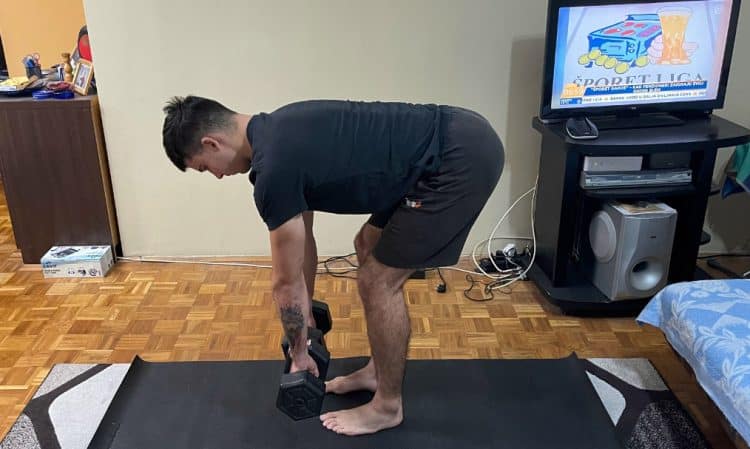
Steps:
- Place a pair of dumbbells on the floor in front of you.
- Stand upright with your feet shoulder-width apart.
- Hinge at the hips and hold the dumbbells with a neutral grip.
- Get into an upright position by primarily engaging the lower back, glutes, and legs, all while keeping your spine in a neutral position.
- Stand straight and lock out your knees and hips to finish the movement.
- Drop both dumbbells on the floor and repeat.
Pro Tip: Maintain a neutral spine and engage your core to protect your lower back during the lift.
Level Up Your Fitness: Join our 💪 strong community in Fitness Volt Newsletter. Get daily inspiration, expert-backed workouts, nutrition tips, the latest in strength sports, and the support you need to reach your goals. Subscribe for free!
Bent-Over Row
The dumbbell bent-over row is excellent for developing upper and lower back muscles, such as erector spinae and lats.
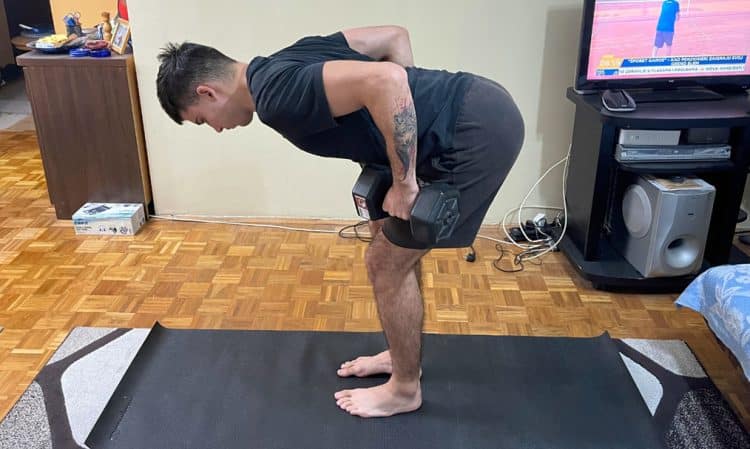
Steps:
- Pick two dumbbells of appropriate weight.
- Stand upright with your knees slightly flexed, feet hip-width apart, and arms extended while holding a dumbbell in each hand.
- Bend forward so your upper body is almost parallel to the ground, and maintain a neutral head and spine.
- Initiate the exercise by pulling both dumbbells toward your hips by flexing your elbows.
- When both dumbbells reach the hip level, reverse the motion to return to the starting position.
- Repeat for recommended reps.
Pro Tip: Squeeze your shoulder blades at the top of the range of motion to maximize upper back engagement.
Dumbbell Superman
Dumbbell Supermans may look easy, but they are an extremely challenging exercise that will effectively activate your whole posterior chain. The bodyweight version of it is challenging enough, and when you add external resistance, such as dumbbells, it takes the exercise to a whole new level.
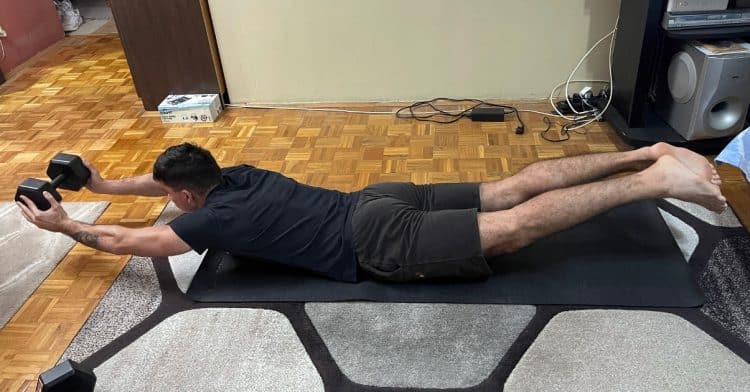
Steps:
- Lie prone on the floor with your feet hip distance apart, and your arms extended overhead.
- Hold a dumbbell in both hands and extend your elbows. Keep your core braces throughout the exercise.
- Slowly raise your arms, head, and thighs off the floor and hold the position.
- Lower your limbs to the floor and repeat for the desired reps.
Pro Tip: Focus on lifting your chest and legs as high as possible to engage your lower back effectively.
Single-Leg Deadlift
Single-leg deadlifts are one of my favorite unilateral posterior chain exercises to build core stabilization [2]. Single-leg deadlifts are excellent for strengthening your lower back muscles, such as erector spinae, multifidus, and quadratus lumborum. They should be incorporated at least once weekly into your workout routine to see the most notable effects.
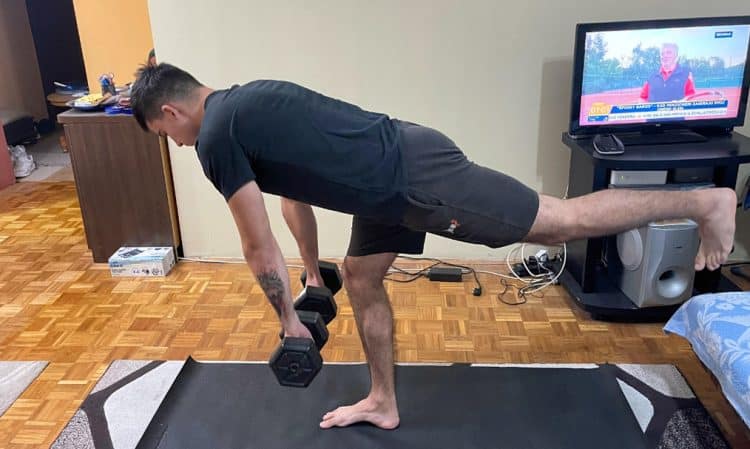
Steps:
- Stand upright with a shoulder-wide stance while holding a dumbbell in each hand.
- Depress and retract your shoulder blades.
- Lift your left leg off the floor and slightly bend your right knee, ensuring it stays fixed in this position during the whole movement.
- Bend forward by hinging at the hips and lift your left leg towards the ceiling behind you in a sweeping motion.
- When your torso is parallel to the floor, reverse the motion to return to the starting position.
- Repeat for recommended reps on each leg.
Pro Tip: Keep your grounded leg slightly bent and your back neutral throughout the movement.
Single-Arm Row
The single-arm dumbbell row is an effective unilateral upper back exercise to help develop your back. It is one of the best dumbbell back exercises to incorporate into your workouts. Nevertheless, perform the exercise with your feet placed together for optimal lower back engagement.

Steps:
- Pick a dumbbell of an appropriate weight in your right hand.
- Place your left hand on an elevated surface like a bench to stabilize your core.
- Position your feet shoulder-width apart and parallel to each other.
- Your torso should be almost parallel to the floor. The lower your torso, the more tension you will experience in your lower back.
- Pull the dumbbell towards your hip by driving your elbow toward the ceiling.
- When the dumbbell reaches the hip level, reverse the motion to return to the starting position.
- Repeat for reps.
Pro Tip: Rotate your torso slightly on concentrics to engage your core and stabilize your body during the row.
Dumbbell Bird Dog Row
Dumbbell bird dog rows are a challenging variation of the bodyweight bird dog exercise that will effectively activate your hips, core muscles, and lower back muscle quadratus lumborum. Bird dog rows can help improve your core strength and stability.
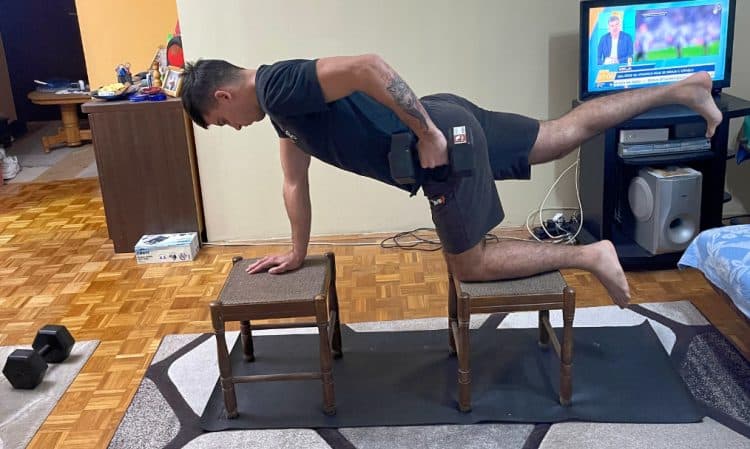
Steps:
- Place your right hand and left knee on a bench to enter the quadrupedal position.
- Pick a light dumbbell for this bird dog variation to avoid butchering your exercise technique.
- Ensure your hands are under your shoulder and perpendicular to the bench, and the angle that encloses your femur and upper body is close to or equal to 90 degrees. Your head should be in a neutral position.
- Start the exercise by lifting your contralateral leg. Hold this position for the duration of the whole exercise.
- Row the dumbbell towards your hips.
- When the dumbbell reaches your hip level, reverse the motion to return the dumbbell to the starting position.
- Make sure to keep your hips neutral during the whole movement.
- Repeat for the desired reps before switching sides.
Pro Tip: Maintain a steady and controlled pace while extending your arm and leg to improve balance and coordination.
Romanian Deadlift
Romanian deadlifts are an excellent deadlift variation that emphasizes developing strong and functional posterior chain muscles such as erector spinae, biceps femoris, semitendinosus, and semimembranosus. Incorporate them during leg or pulling days at least once weekly to make sure your posterior chain and lower back stay healthy, strong, and, therefore, functional.

Steps:
Level Up Your Fitness: Join our 💪 strong community in Fitness Volt Newsletter. Get daily inspiration, expert-backed workouts, nutrition tips, the latest in strength sports, and the support you need to reach your goals. Subscribe for free!
- Stand upright with a shoulder-width stance and grab two dumbbells of appropriate weight with an overhand grip in front of your thighs.
- While maintaining slight knee flexion, lower your torso toward the floor by hinging at your hips.
- Keep your spine and head neutral and knees slightly bent throughout the exercise,
- Aim for a deep hamstrings and glutes stretch at the bottom of the range of motion. Hold this position for one second.
- Reverse the motion to return to the starting position.
Pro Tip: Push your hips back while keeping your knees slightly bent to target your hamstrings effectively.
Good Mornings
Dumbbell good morning is similar to the Romanian deadlifts. They are an excellent exercise to bulletproof your posterior chain and improve overall stability and performance.
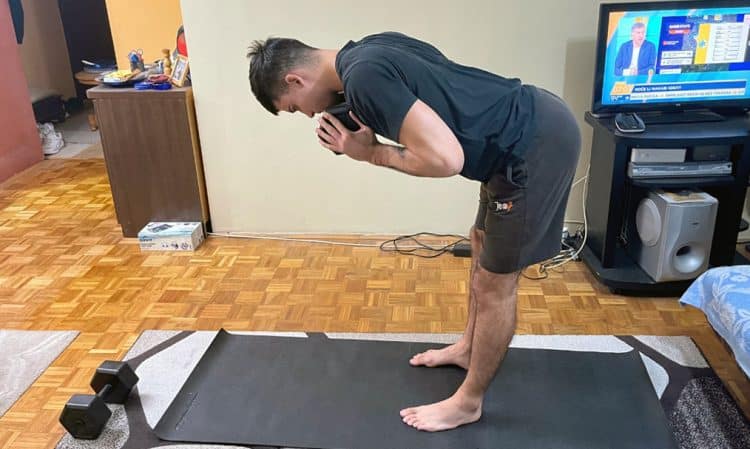
Steps:
- Pick one dumbbell of an appropriate weight.
- Stand upright with a shoulder-width stance and hold the dumbbell between your hands against your clavicle bone, similar to the goblet position.
- Lean forward by flexing your hips while maintaining slight knee flexion.
- Go as low as your mobility allows.
- Reverse the motion to return to the starting position.
Pro Tip: Focus on hip hinge mechanics and maintain a straight back while bending forward to target your lower back and hamstrings.
Glute Bridges
The glute bridge is a hip and core-strengthening exercise that will activate your glutes, hamstrings, and abs.
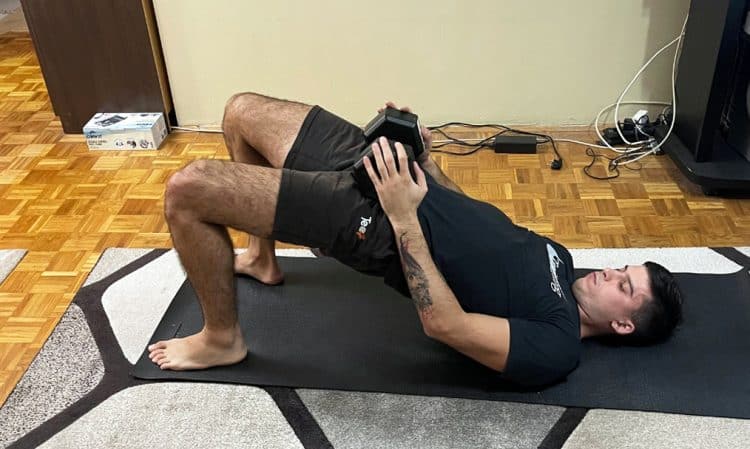
Steps:
- Lay on your back on the floor and bend your knees and hips to move your heels closer to your butt.
- Place the dumbbell on your hips and hold onto it so it doesn’t move during the exercise.
- Turn your toes slightly outwards, just like when performing the hip thrust exercise.
- Start the exercise by lifting your butt off the floor and pushing it towards the ceiling. Hold the contraction for one second.
- Reverse the motion to return to the starting position.
Pro Tip: Squeeze your glutes at the movement’s top to maximize glute activation and avoid overarching your lower back.
Jefferson Curls
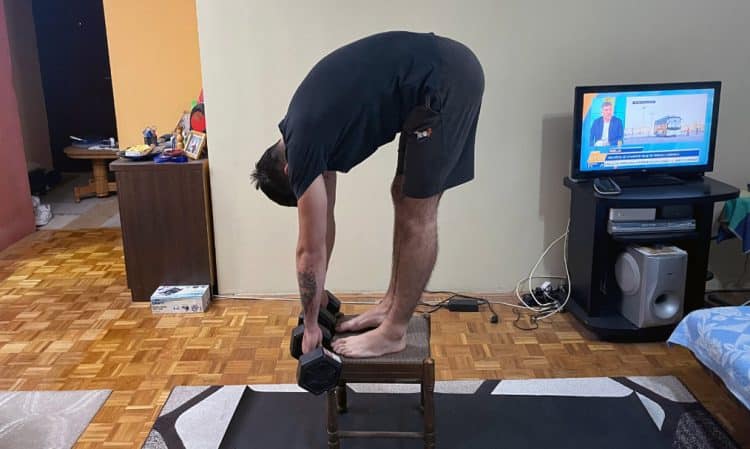
The Jefferson curl is a controlled, rounded-back deadlift variation that targets all posterior chain muscles, including the hams, glutes, and upper and lower back. It’s particularly effective for strengthening the lower back because it emphasizes spinal articulation and controlled flexion (bending), which can help improve spinal health and stability when done with proper weights.
Steps:
- Stand on an elevated surface and place your feet close to each other.
- Hold a dumbbell in each hand in front of your thighs.
- Start the exercise by bending forward. Round your back during the eccentric phase to achieve greater depth.
- When you reach the maximum depth, reverse the motion to return to the starting position.
Pro Tip: Start with light weights and gradually increase the load while maintaining a slow and controlled movement.
Example Lower Back Dumbbell Workout
Begin your lower back workout with a 10-minute warm-up session that includes:
- Light cardio (e.g., brisk walking, jogging, or cycling)
- Dynamic stretches focusing on the hamstrings, glutes, and lower back.
After completing the warm-up, perform the following workout:
| Exercises | Sets | Reps | Rest (in seconds) |
| Deadlifts | 4 | 6-8 | 90 |
| Romanian Deadlift | 3 | 10 | 90 |
| Bent-Over Rows | 3 | 10-12 | 60 |
| Single-Leg Deadlifts | 3 | 10 (each leg) | 60 |
| Good Mornings | 3 | 12-15 | 60 |
| Glute Bridges | 3 | 15-20 | 45 |
Cool Down (5-10 minutes)
- Static stretches focusing on the hamstrings, glutes, and lower back.
- Use a foam roller for myofascial release.
Notes:
- Always prioritize proper form and technique to avoid injury.
- If you are unfamiliar with these exercises, seek a professional’s help.
- Adjust the weights, sets, and reps based on your fitness level and goals.
FAQ’s
How can I train my lower back with dumbbells?
You can train your lower back with dumbbells by performing exercises such as dumbbell deadlifts, single-leg deadlifts, and dumbbell rows. If performed with proper form, these exercises are more than enough to maximize benefits and reduce injury risk.
Can I build my lower back with dumbbells?
Yes, you can build your lower back muscles with dumbbells. Dumbbells are extremely effective at targeting and building various back muscles through exercises like rows, deadlifts, and flyes.
Should I train my lower back?
Yes, you should definitely train your lower back, as it is essential for developing overall back strength, improving posture, and reducing the risk of injury.
What exercises should I avoid if I have lower back pain?
Some of the exercises you should avoid when experiencing lower back pain include deadlifts, squats, and leg presses without proper form or guidance. You should consult a professional before starting a routine if you are dealing with pains or injuries.
Wrapping Up
In summary, building a stronger lower back necessitates incorporating a variety of exercises into your training regimen, extending beyond basic dumbbell variations, as commonly believed.
Regularly incorporate core exercises into your routine to build a strong lower back. Exercises like dead bugs and plank variations can help enhance your core’s isometric strength and endurance. This, in turn, plays a critical role in stabilizing your lower back effectively.
In the comments below, let me know your favorite exercises for strengthening your lower back.
More on Back Training Insights:
While this guide offers a thorough overview of lower back training, it’s just the tip of the iceberg. There’s a wealth of knowledge on back training out there waiting for you. Dive into your next enlightening read below:
- 15 Best Compound Back Exercises + Workouts
- The Best 30-Minute Back Workout for Size and Strength
- The 8 Best Lower Back Exercises + Workout
- The 15 Best Cable Back Exercises & Workouts to Level Up Your Training
- 13 Best Bodyweight Back Exercises For A Yoked Posterior Chain
- Best Old-School Back Workouts
- Best Back Exercises to Build Strength and Muscle for CrossFit
- Best Back Workouts to Protect you Against Injury and Build Strength
References:
- Fischer SC, Calley DQ, Hollman JH. Effect of an Exercise Program That Includes Deadlifts on Low Back Pain. J Sport Rehabil. 2021;30(4):672-675. Published 2021 Feb 24. doi:10.1123/jsr.2020-0324
- Diamant W, Geisler S, Havers T, Knicker A. Comparison of EMG Activity between Single-Leg Deadlift and Conventional Bilateral Deadlift in Trained Amateur Athletes – An Empirical Analysis. Int J Exerc Sci. 2021;14(1):187-201. Published 2021 Apr 1.







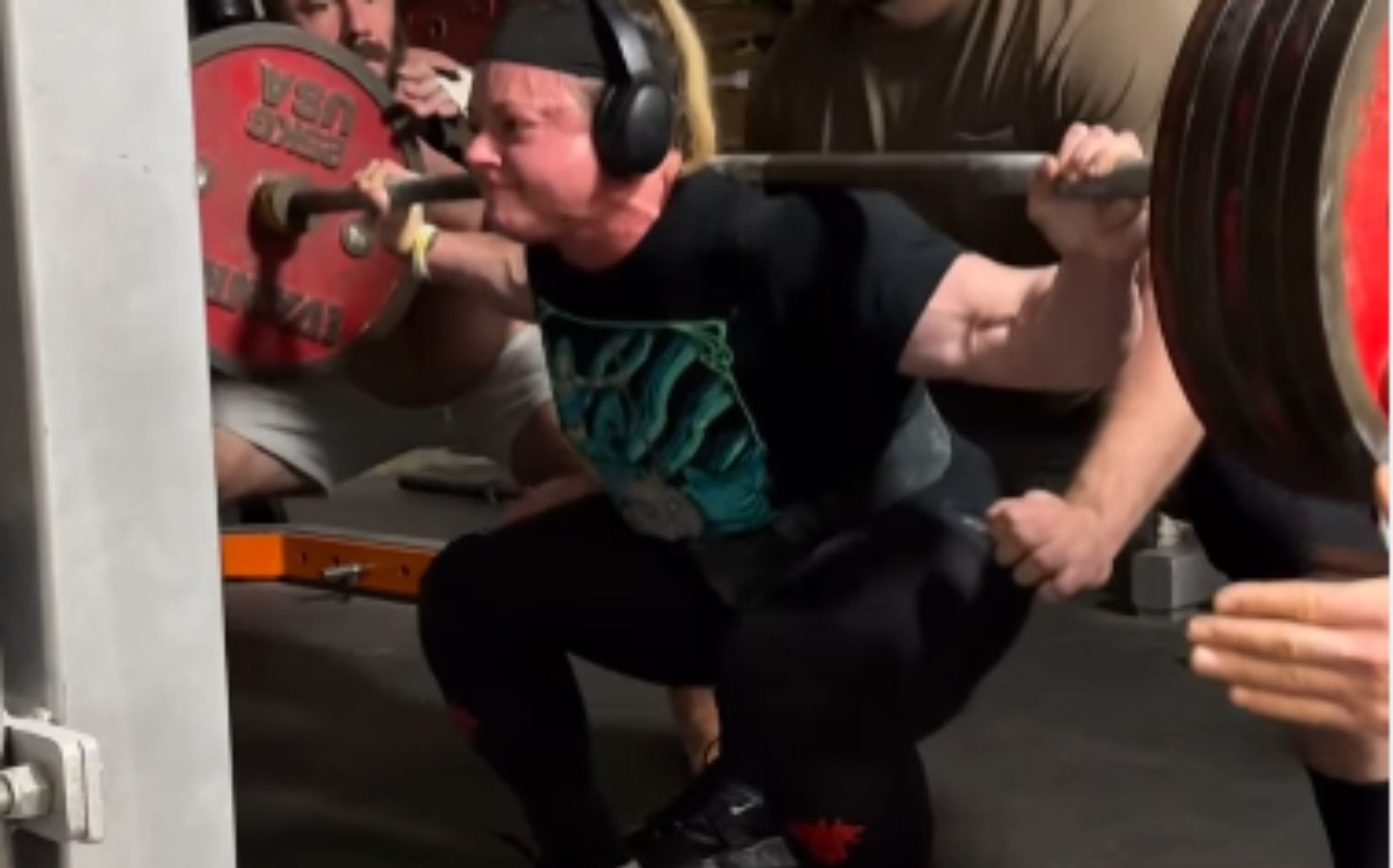

Awesome article, thank you!
What would be the minimum weight to start with (that will have some effect) for sedentary folks like me who spend 10-15 hours a day working on a laptop?
I have a chronic lumbar pain. Fitness level: next to none.
Thank you for your feedback on the article! Starting with a light weight, such as 5-10 pounds, is advisable to maintain proper form and prevent any further strain on your lumbar area. It’s crucial to consult with a healthcare professional before beginning any new exercise routine, especially given your chronic lumbar pain and sedentary lifestyle. Remember, it’s always better to start lighter and gradually increase the weight as your strength improves.